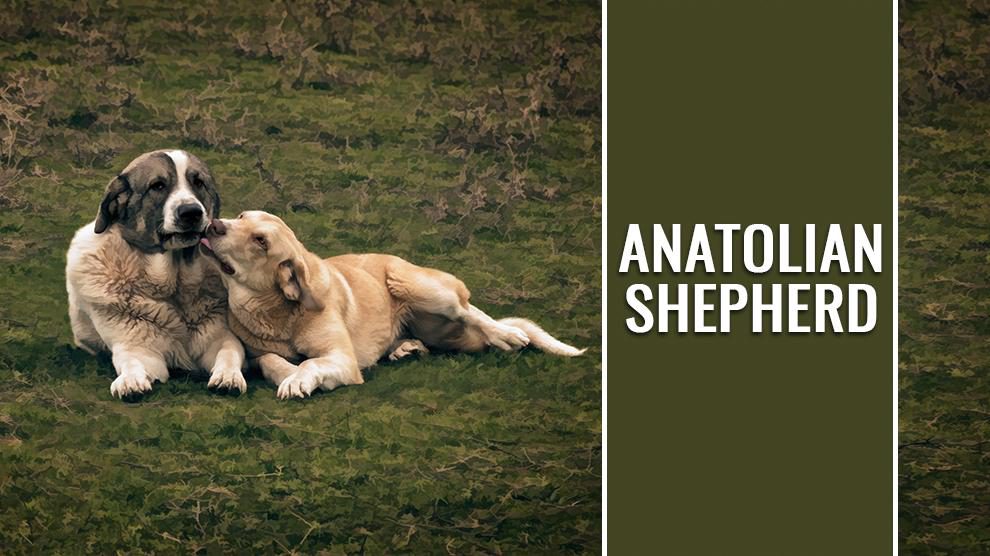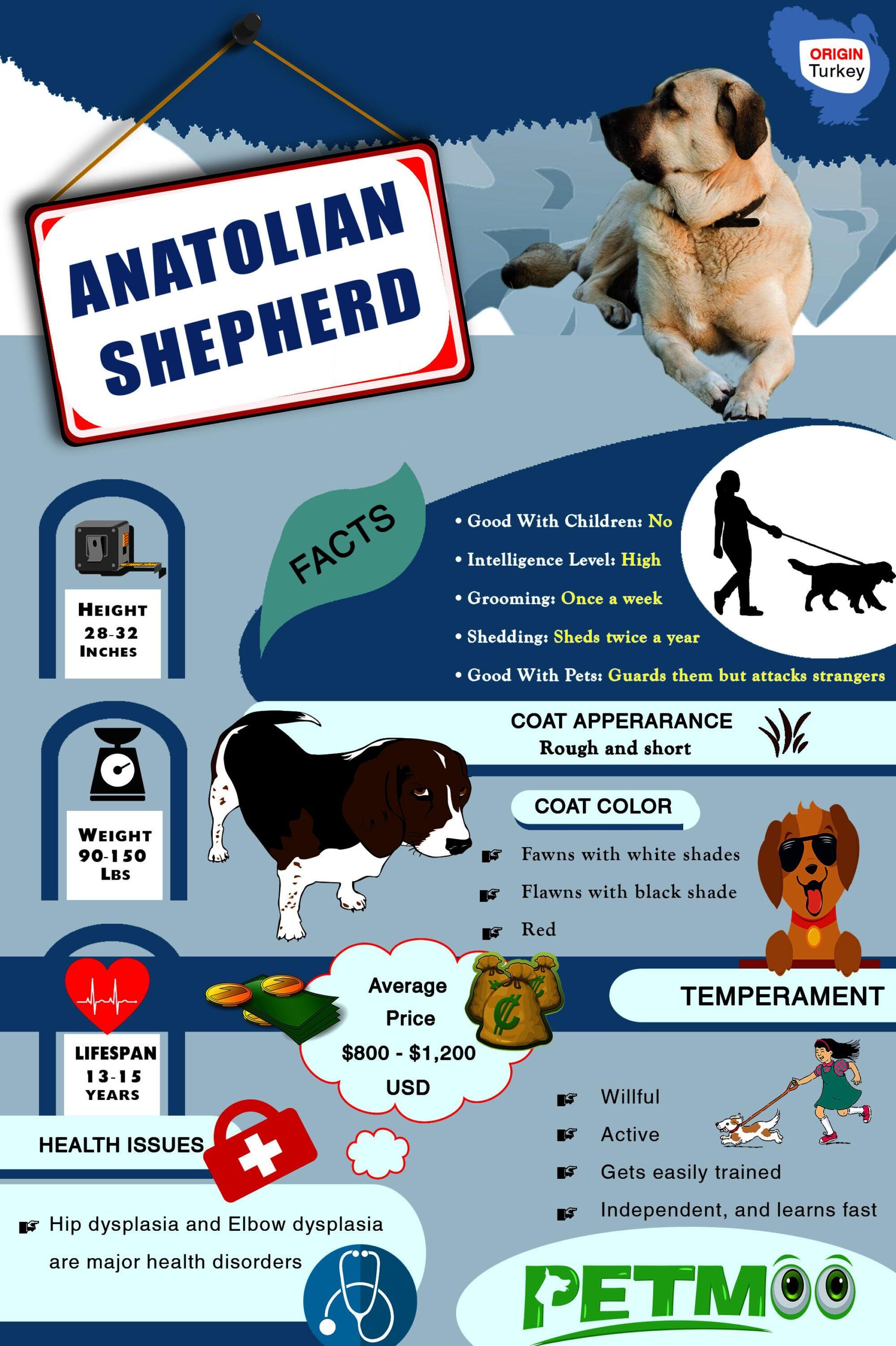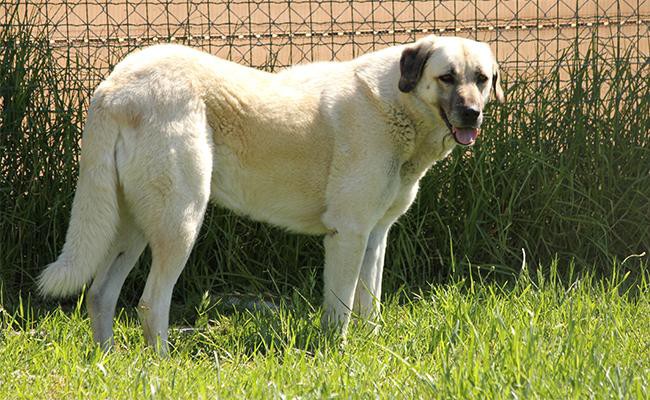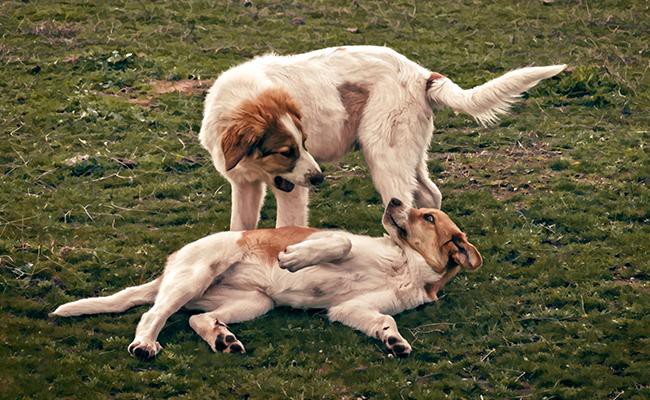Dog Pregnancy Calculator And Timeline
Anatolian Shepherd is a large powerful dog in Anatolian that is generally used for guarding sheep. They work really hard and can adjust in any climatic condition either high temperatures in summer or cold freezing climates in winter.
Anatolian Shepherd is believed to be a part of a very old dog breed which is probably thought to have descended from some strong hunting dog breed in Mesopotamia.
Later this breed was grown up over a period of time to fulfill certain particular requirements.
The formative is considered as a climate (too hot, dry climate and freezing winters), lifestyle (nomadic, partly nomadic, and sedentary), and responsibilities (guarding animals by going about long distances in the Central Anatolian Plateau).
These dogs are happy living outside throughout the year which defines their proverbial resilience.
These large, sturdily grown-up dogs with wide strong heads and heavy double-layered coats are vigorous but also very quick. These dogs are usually well-mannered and bold without any aggressiveness.
They live independently as they are very intelligent and self-assured. It is a quite obedient and proud breed that remains faithful to its owners. It pours in affection for its masters however as it grows to be an adult it doesn’t trust strangers.
Anatolian Shepherd Breed Characteristics
- Origin: Turkey
- Size: Large dog breed
- Dog Breed Group: Flock guard
- Lifespan: 13 to 15 years
- Height: 28-32 inches (71-76cms)
- Weight: 90 to 150 pounds(41 to 68kg)
- Coat Appearance: Rough and short
- Coat Colors: Flawns with black shade, Red, Fawns with white shades
- Temperament: Willful, active, gets easily trained, independent, and learns fast
- Good With Children: No
- Intelligence Level: High
- Good With Pets: Guards them but attacks strangers
- Grooming: Once a week
- Shedding: Sheds twice a year
- Suitable For Apartments: Not a suitable pet for Apartments as it is very suspicious to unknown people
- Need For Exercise: 60 to 120 minutes every day
- Easy To Train: Gets trained easily, Smart, potential mouthiness and prey drive
- Good For First Time Owners: Suspicious to strangers but gets acquainted after it gets well with them
- Health Issues: Hip dysplasia and Elbow dysplasia are major health disorders
- Litter Size: 5 to 10 puppies
- Average Price: $665
Anatolian Shepherd History
Anatolia, As Anatolia or Asia Minor, is the peninsula that is part of the Asian part of Turkey.
It was in this place during civilization beginning of the sheep and goat herders grew livestock to guard the animals which were called Coban Kopegi (Shepherd’s Dog) which has taken the place or name of an Anatolian shepherd in today’s world.
Usually, the central part of Anatolia is a tall plateau with lots of plains and rolling mountains. Summery is very dry and hottest and winters have snowfall with temperatures falling below zero.
Even during such harsh tough climatic conditions, the Anatolian shepherd kept up its name as a flock guardian supreme.
Artifacts of ancient times especially the Babylonian empire times have records of this breed’s ancestors.
The British Museum has Assyrian bas relief carvings that date back to 2000 b.c and these carvings resemble huge dogs that look similar to Anatolian Shepherd.
The olden day’s books of the bible say about shepherds which are generally dogs that are some slight variation of the Anatolian.
The history of this breed in America starts soon after a few years after World War II. It was when the Department of Agriculture brought down a breeding set of dogs from Turkey to take part in the top-secret “Sheepdog Project”.
This program was basically to trace which breed would be suitable for the process of American sheep pastures. As the war broke out the project couldn’t proceed further so the Anatolians and their little ones were let out.
American ranchers started to import these Anatolian breed dogs after the war in the 1950s however, the breed has a steady place in the country during the 1970s.
The praises for bringing the Anatolian breed to America and establishing it strongly go to Lieutenant Robert Ballard from the US Navy who brought along with him a pair of Anatolians from Turkey.
After settling the Anatolians in America, in 1970 Mr. Robert bred his first litter which gave the US breeders their initial stock.
This new breeding process got merged with the Endangered Species Act. The new legal condition required the ranchers to control the number of predatory wolves without hurting or killing them.
Anatolian Shepherds which intimidate predators rather than quarreling with them, perfectly fit the job. Even today there are many Anatolian shepherds who work as ranch dogs by guarding everything like sheep, goats Llamas, and ostriches.
Anatolian Shepherd Size
Anatolian Shepherds are large-sized dogs. On average, males typically stand between 29 to 32 inches (74 to 81 cm) tall at the shoulder, while females are slightly smaller, ranging from 27 to 30 inches (69 to 76 cm) in height.
In terms of weight, males typically weigh between 110 to 150 pounds (50 to 68 kg), while females generally weigh between 80 to 120 pounds (36 to 54 kg).
However, it’s important to note that individual Anatolian Shepherds may vary in size, and there can be some overlap within the breed’s size range.
- Male size: 29-32 inches
- Male weight: 110¼-143¼ lbs
- Female size: 28-31 inches
- Female weight: 88-121¼ lbs
Anatolian Shepherd Lifespan
The average lifespan of an Anatolian Shepherd is typically between 10 to 13 years. However, it’s important to note that various factors can influence an individual dog’s lifespan, including genetics, overall health, diet, exercise, and veterinary care.
Providing proper nutrition, regular exercise, routine veterinary check-ups, and a safe, loving environment can contribute to a longer and healthier life for an Anatolian Shepherd.
Additionally, some dogs may live beyond the average lifespan with proper care and attention to their specific needs.
Anatolian Shepherd Appearance
The dog has a short coat that is dense and the undercoat is quite thick. Due to its short coat, its grooming requirement is very minimal with just brushing neatly once a week.
Similar to other dogs like them these active pets also require good exercise and also stimulation for the mind to keep boredom away. It likes to be in the company of humans however, it enjoys a lot more outdoors than inside a house.
Its skull is quite big flat and broad between its ears and male dogs have a larger head than females. The muzzle is usually one-third of its size and lips give a square shape. Its nose, lips, and eye rims are generally in black shade.
The Anatolian body must be maintained balanced and must showcase power and strength. It moves around in a supple and powerful manner.
The notable feature of this breed is the head carriage being low which makes its head, neck, and top-line move in a level by creating a look as if the dog is stalking.
The Anatolian shepherd dog is generally of height 28-32 inches / 71-81 cm in the shoulder level and its weight usually crosses 140 pounds / 63.5 kg.
Anatolian Shepherd Colors
The Anatolian Shepherd Dog, also known as the Kangal Shepherd Dog, is a breed that originates from Anatolia, which is now modern-day Turkey. The breed is known for its protective instincts and is often used as a livestock guardian.
In terms of coat colors, Anatolian Shepherds come in a variety of shades. The most common colors include:
1. Fawn: This is the most frequently seen color in Anatolian Shepherds. It ranges from light cream to a reddish-tan hue.
2. Sable: Sable-colored Anatolian Shepherds have a base color ranging from light cream to pale fawn, with darker individual hairs that create a shaded or “sabled” appearance.
3. Brindle: Brindle Anatolian Shepherds have a base color with dark striping or streaking, often in a pattern similar to a tiger’s stripes. The base color can vary and may be fawn, tan, or even gray.
4. White: While not as common as the other colors, Anatolian Shepherds can also be predominantly white. However, it’s worth noting that solid white dogs are not typically accepted by breed standards and may be considered a fault in show competitions.
Anatolian Shepherd Mix
Certainly! Here are some details about each type of Anatolian Shepherd mix:
Anatolian Shepherd German Shepherd Mix:
This mix may inherit the Anatolian Shepherd’s protective instincts and the German Shepherd’s intelligence and versatility. They can make excellent working dogs or loyal family companions.
Anatolian Shepherd Labrador Retriever Mix:
This mix could result in a combination of the Anatolian Shepherd’s guardian instincts and the Labrador Retriever’s friendly and outgoing nature. They may make loving family pets that are also good with children.
Anatolian Shepherd Golden Retriever Mix:
This mix may offer a blend of the Anatolian Shepherd’s protective instincts and the Golden Retriever’s gentle and friendly demeanor. They could be affectionate family companions with a good temperament.
Anatolian Shepherd Rottweiler Mix:
This mix could result in a combination of the Anatolian Shepherd’s guarding abilities and the Rottweiler’s strength and loyalty. They may require experienced owners and proper socialization and training.
Anatolian Shepherd Siberian Husky Mix:
This mix may inherit the Anatolian Shepherd’s protective instincts and the Siberian Husky’s independent and energetic nature. They may require ample exercise and mental stimulation.
Anatolian Shepherd Boxer Mix:
This mix may offer a combination of the Anatolian Shepherd’s guarding instincts and the Boxer’s playful and energetic personality. They may be loyal and protective family pets.
Anatolian Shepherd Pit Bull Mix:
This mix could result in a combination of the Anatolian Shepherd’s protective instincts and the Pit Bull’s strength and loyalty. They may require responsible ownership and proper socialization.
Anatolian Shepherd Great Pyrenees Mix:
This mix may offer a blend of the Anatolian Shepherd’s guarding abilities and the Great Pyrenees’ calm and gentle nature. They may make excellent livestock guardians or family pets.
Anatolian Shepherd Mastiff Mix:
This mix could result in a combination of the Anatolian Shepherd’s protective instincts and the Mastiff’s size and strength. They may require early socialization and training due to their potential size.
Anatolian Shepherd Akita Mix:
This mix may inherit the Anatolian Shepherd’s guarding instincts and the Akita’s loyalty and independence. They may require experienced owners and firm training.
Anatolian Shepherd Personality
Anatolian Shepherds are known for their distinct personality traits. Here are some key characteristics of their personality:
- Protective: Anatolian Shepherds have a strong protective instinct. They are naturally inclined to guard and protect their family, property, or livestock. They can be vigilant and wary of strangers, making them excellent watchdogs.
- Independent: Anatolian Shepherds have an independent nature. They are capable of making decisions and assessing situations on their own. This trait can make them self-reliant and less reliant on constant direction from their owners.
- Loyal: Anatolian Shepherds are fiercely loyal to their family. They form strong bonds with their owners and are dedicated to protecting and caring for them. Their loyalty extends to their duties as working or guardian dogs as well.
- Calm and Confident: Anatolian Shepherds typically have a calm and composed demeanor. They exhibit confidence in their abilities and display a steady and stable temperament.
- Reserved with Strangers: Anatolian Shepherds can be reserved or aloof with unfamiliar people. This is part of their protective nature and their tendency to be cautious and observant when encountering new individuals or situations.
- Gentle and Patient: Despite their protective instincts, Anatolian Shepherds are generally gentle and patient with their family members, including children. They can be tolerant and understanding, especially when properly socialized from a young age.
- Intelligent: Anatolian Shepherds are intelligent dogs that can learn quickly. They are receptive to training but may have an independent streak, so consistent and patient training methods work best with them.
- Moderate Energy Level: Anatolian Shepherds have a moderate energy level. They typically have bursts of energy for activities such as guarding or working, but they are generally calm and content to relax when indoors or in a calm environment.
Anatolian Shepherd Care
This breed is a hardy dog breed that lives comfortably outdoors, indoors, and both. This isn’t a breed that can be taken care of in a kennel or can be tied at the end of a chain.
They are to be tamed in a yard that is well-fenced. The fence needs to be at least 6 ft tall as it is a large dog. The fence needs to be high enough not just for their safety but also to be cautious about other pets or people who may cross its turf.
It is very important to keep an eye on other’s protection because it tends wary at the sight of strangers.
It is very important to socialize Anatolian shepherds right from their puppyhood. Training to obey and proper leadership also needs to teach this breed as they are strong-willed pets.
As they have their own thoughts it is difficult to make them obey the owner’s whim. Guarding and protection attitude doesn’t require any training for this breed.
As maturity grows within them their protecting nature also matures. By 18 months old they generally take up the role of the guardian on their own.
Anatolian Shepherd Grooming
As it is an outdoor pet the Anatolian is born with a thick undercoat that protects it from any hurt or harm from the external elements.
Certain Anatolians have a lengthy outer coat; however, in most of cases, it is pretty short. A quick brush-through weekly once is sufficient to make it look adorable.
The Anatolian breed sheds its undercoat twice a year. While the shedding happens never ignore to brush off its hair as it will help to clean away from its dead hair.
Use a short bristle brush or a comb to comfortably brush off its hair every few days. Just like other breeds do trim Anatolian shepherd’s nails regularly.
Anatolian Shepherd Training
As this breed happens to be wary of others and instinctively guards an Anatolian pup needs to be socialized. Training to obey is very essential for this breed.
The Anatolian was bred to perform on its own and make decisions independently and guard its flock from strangers.
However, training this breed to listen to the commands of the owners is a challenging task. It is never required to train this Anatolian Shepherd breed as a protection or guard dog.
Anatolian Shepherd Puppy Names
Anatolian Shepherd Male Puppy Names
- Erol
- Hero
- Aslan
- Metin
- Amos
- Egemen
- Leon
- Sinop
- Emmad
- Engin
Anatolian Shepherd Female Puppy Names
- Rosa
- Kiral
- Adana
- Hilda
- Melda
- Esana
- Delma
- Carla
- Alanya
- Anto
Anatolian Shepherd Food
The Anatolian shepherd performs well when fed good quality dog food either commercially packed food or food which is prepared at home with the approval of the veterinarian and under his supervision.
Whatever you feed the puppy it must be apt for its age. The Anatolian shepherd doesn’t overeat. Treats are an essential aid while training the dog however; never give too many treats as they may end up in obesity.
Find out foods that the dog can eat which humans eat. Do have regular checkups with the vet to know whether the dog is within the acceptable weight and whether your diet chart is correct for the dog’s health. Never miss providing clean fresh water to the dog at all times.
Anatolian Shepherd Health Problems
Anatolian shepherds are known to be a healthy breed but just like other dog breeds they too have certain health complications that may arise.
It is not necessary all Anatolian shepherds would have any of these or all of these disorders but if you are considering buying an Anatolian or you have one, it is good to know about the breed’s health in detail.
Hip dysplasia
It is a health disorder that is known to be an inherited problem. It is an issue wherein the thighbone of the dog doesn’t fit properly in the hip joint.
Dogs with this issue suffer pain or certain dogs may also become lame either in one or both rear legs. Some dogs show no sign of such disorder but the same can be diagnosed by x-ray screening.
However, such dogs tend to develop arthritis in the future as it gets old. Dogs with such disorders must not be bred.
Elbow Dysplasia
Just like hip dysplasia, this is also a degenerative sickness. This is said to be caused due to abnormal growth and lack of development which results in a malformed and weak joint.
The severity of the disease varies from dog to dog. Few dogs develop arthritis and some of them become lame.
Treatment for this disorder varies from surgery, weight management, medical management, and anti-inflammatory doses.
Demodectic Mange
Demodectic Mange is otherwise called demodicosis. This malady is usually caused by the Demodex mite. The mite can be transmitted to other pups or even humans.
Usually, this mite is passed from the mother to its pups and this usually happens within a few days after birth. The Demodex mite is usually found in hair follicles and it doesn’t cause any problems generally.
If your dog suffers from a weak immune system there are chances of the dog being affected by demodectic mange.
The usual symptoms of this disorder are pale skin with hair loss, and red, scaly skin with hair loss in the head, neck, and forelegs.
It is generally considered a puppy disease and it gets cured on its own. It affects the complete body and is seen mostly in older puppies and young adult dogs.
Hypothyroidism
It is an illness caused by the thyroid gland. It is considered the main reason for issues such as epilepsy, alopecia (hair loss), obesity, lethargy pyoderma, hyperpigmentation, and other skin-related problems. It gets cured with proper medication and diet.
Entropion
Entropion is the condition in which the eyelids rotate inwards which usually affects both the eyes. It gives irritation and also ends up impairment of vision.
It usually occurs before the dog is one year old however the treatment for this disorder must be carried out till the dogs become adults.
The major treatment for this issue is multiple surgeries performed over a period of time to protect the dog from ectropion wherein the eyelids begin to roll out of the eyelid.
Anatolian Shepherd Interesting Facts
- Anatolian shepherds are quite sensitive to Anesthesia.
- Anatolian shepherds have been featured in various movies such as Kate and Leopold and Friends with a Benefit.
- Anatolians have been a great support in the cheetah conservation campaign in Namibia since 1994. The conservation fund has begun to advise ranchers to utilize Anatolian shepherd dogs to guard their flocks to decrease the need to kill cheetahs.
- Anatolian Shepherd is known to be extraordinarily independent. Their instinct is to protect themselves and guard the flocks without any command.
- Although Anatolians are very protective in nature they remain calm, friendly, and have loving bonding with their immediate family.
- Anatolian shepherds are also called Goban Kopegi, Anatolian Karabakh, or Kangal.
- They were in ancient times bred to guard flocks against predators.
- They traveled to the U.S. for a secret government campaign.
- They have protected many endangered species in America.
Anatolian Shepherd Price
The price of an Anatolian Shepherd Dog can vary depending on various factors, including the dog’s lineage, age, location, breeder reputation, and the demand for the breed.
Additionally, if you are looking for a dog with specific qualities, such as a show-quality or working-line Anatolian Shepherd, the price may be higher.
On average, you can expect to pay anywhere from $500 to $2,000 for an Anatolian Shepherd Dog from a reputable breeder.
However, it’s important to note that the initial purchase price is only one aspect of owning a dog. You should also consider ongoing expenses such as veterinary care, food, grooming, training, and other supplies.
Anatolian Shepherd Breeders
When selecting Anatolian Shepherd breeders, it’s crucial to prioritize the health, temperament, and overall well-being of the dogs. Here are some tips:
1. Research: Gather information on the breed, its standard, and common health issues to ask informed questions.
2. Reputable Breeders: Look for breeders with a good reputation, established track record, and involvement in Anatolian Shepherd clubs or organizations.
3. Health Testing: Ensure that the breeder conducts health tests on their breeding dogs to minimize the risk of genetic diseases.
4. Temperament and Socialization: Interact with the breeder’s dogs and assess their temperament. A responsible breeder will prioritize proper socialization.
5. Contract and Support: A reputable breeder will provide a written contract, health guarantees, and ongoing support for the lifetime of the dog.
6. Visit the Breeder: Arrange a visit to the breeder’s facility to assess the living conditions and meet the dogs in person.

Click here to find Anatolian Shepherd breeders in the USA.
Anatolian Shepherd FAQs
1. What Is Anatolian Shepherd Bite Force?
Bite force can vary significantly among different breeds, but also among individual dogs within the same breed, and it can depend on several factors, including the size of the dog and its individual health and strength.
It’s often stated that an average dog might have a bite force of around 200-300 PSI, while some of the breeds with the strongest recorded bite forces, such as the Kangal or Mastiff, have measurements over 700 PSI.
Anatolian Shepherds are a large and powerful breed, and as they’re closely related to the Kangal, the force may resemble them. However, it is important to note that all dogs are different and their biting force is different always.





















